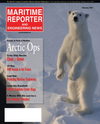
Page 44: of Maritime Reporter Magazine (February 2011)
Cruise & Passenger Vessel Annual
Read this page in Pdf, Flash or Html5 edition of February 2011 Maritime Reporter Magazine
mediate reason appear as any one or a combination of the following causes: a) to retain qualified crew, b) to improve communication between key equipment experts and ships’ crew, c) to enable the exchange of operational experience be- tween land support staff and ships offi- cers, d) to enable crew to stay in contact with family and friends and attend to per- sonal matters. Because people run ships and when you keep the best crew on the job, ensure they stay focused on their job, give them online and offline support from vendors of key equipment, provide online support from IT staff, keep computer sys- tems updated and do all this in real time and at high speed, ships are kept running and earning money for the owner — which is what shipping is about.
Frost, GE Satcom There are es- sentially two drivers. The first is crew welfare, the second is efficiency. With improving electronic bridge systems the need to network these between ship and shore is becoming more important. Data collection is typically performed cen- trally on shore combined with processing and (re)distribution back out to shipping fleets to enable the efficient operation of commercial fleets. Typical applications include weather, chart and routing and could extend to cargo monitoring, secu- rity and on-board plant efficiency using
SCADA.
Jensen, Thrane & Thrane The need to move more and more data for ap- plications like crew welfare, remote maintenance and monitoring. Simply the need to stay in touch for operational or personal reasons.
Rosenberg, PortVision The biggest driver for improved satellite communica- tions is that customers are demanding more services, more data and, conse- quently, a bigger pipe. Increasing de- mand has resulted in economies of scale for both the communications services and hardware manufacturers, which has re- sulted in greater bandwidth at lower price, which has further increased de- mand.
Fisher, Mackay Simply put, faster throughput has enabled more software applications to be developed for fleet op- erators. Tasks that were once done on shore are now being handled by the ves- sels themselves. It has taken a long time to see this become a reality, but compa- nies are requiring more than just com- munication equipment, they want solutions.
Einshøj, Intellian Need for in- ternet access both utilizing company IP standards internally as well as getting ac- cess to the external information and serv- ices equal to what’s offered at shore.
O’Brien, Iridium At the mo- ment, crew welfare calling – including phone, e-mail and Internet – is primary driver in the industry. Crew morale and retention have an impact on the bottom line since the cost of recruiting and re- training crew is expensive. The other driver is the never-ending quest for lower monthly satellite communication costs.
What trends do you see today that you believe will fundamentally change the market in the coming decade?
Weintraub, MTN Over the next five to ten years, I expect to see more de- velopment of new satellite frequencies, which will allow users to communicate with higher bandwidths and smaller an- tennas. This could come out as wide area
Ka-band or higher power Ku-band satel- lites covering larger footprint areas. With the current development of spread spec- trum and CDMA, it will allow users “to continue to push the envelope” when bandwidth requirements exceed today’s capabilities. The higher frequencies will allow for smaller and lighter terminals used in the field for military and govern- ment operations. We can expect to see many new antenna designs being deliv- ered using flat-array technology instead of the more commonly used parabolic or dish antenna.
Clark, DeltaWave Free use of the internet and the availability of com- munications over the airwaves. The total accessibility of the internet and the use of streaming video to have instant contact.
Fisher, Mackay I see more competition with L-Band technologies and Ku and Ka products. Customers will have a wider variety of product choices and value- added services to match their unique communications requirements. There will be a vast array of communications solutions from simple handheld L-Band products with docking stations, to a vari- ety of L-Band FleetBroadband terminals, additional Ku offerings, and the upcom- ing Global Express products. The cus- tomer will be the beneficiary, enabling more cost-efficient and a reliable com- munications.
O’Brien, Iridium The prolifer- ation of VSAT service providers in the maritime market will have a big impact, although the large gaps in VSAT cover- 44 Maritime Reporter & Engineering News
FEATURE SATELLITE COMMUNICATIONS ROUNDTABLE
Seacor Joyce McCall, which is now located in the Caspian Sea. (Photo: Broadpoint
Stratos recently deployed FleetBroadband on 16 vessels for Germany's Vega-
Reederei GmbH & Co. (Vega).
Iridium
Ted
O’Brien
We are moving forward with our next-generation satellite constella- tion under the Iridium NEXT pro- gram.
Thrane & Thrane
Casper
Jensen
Downturn or not, we have not re- duced our development of new products. We are continuously de- veloping our VSAT offering ...

 43
43

 45
45
